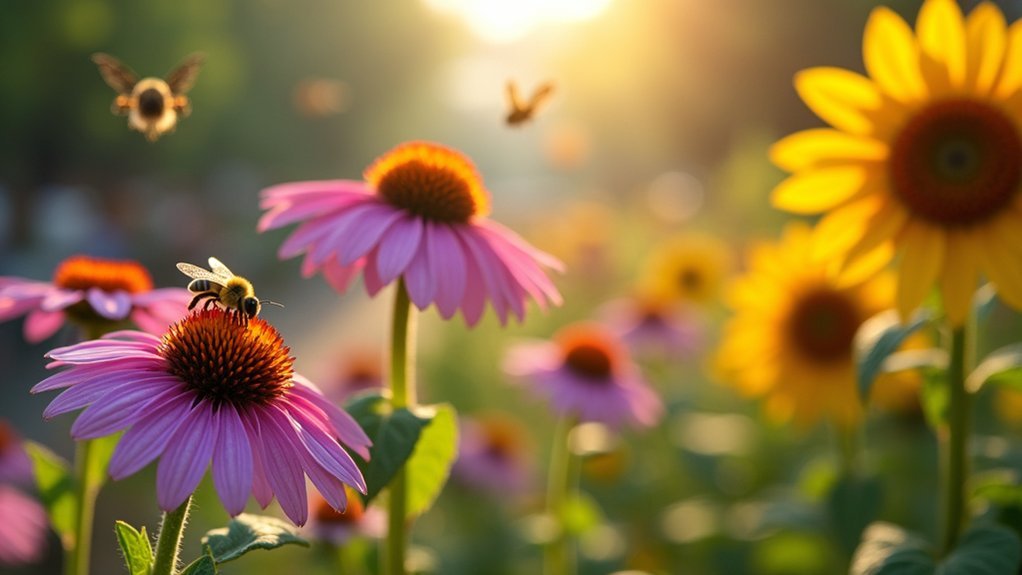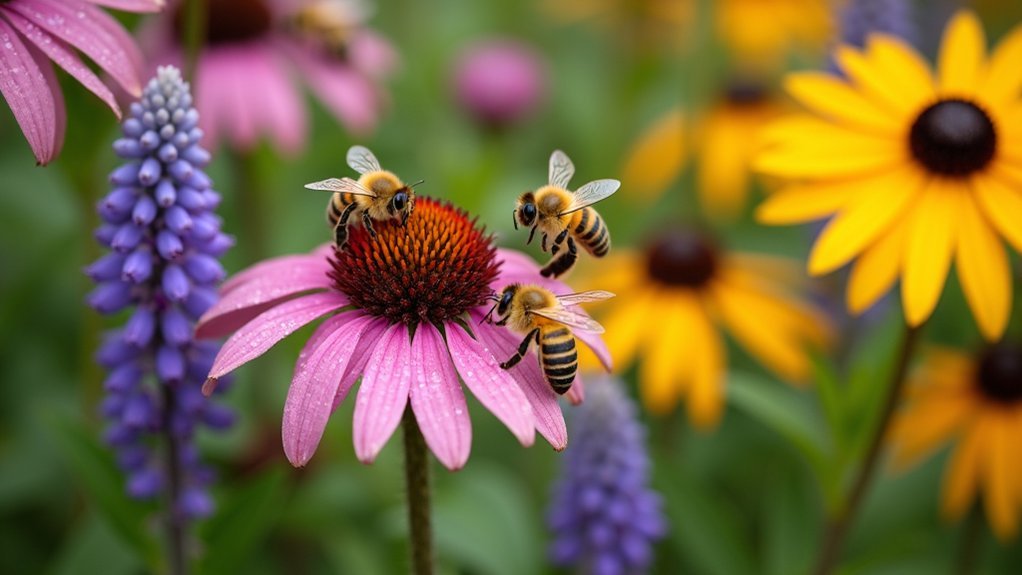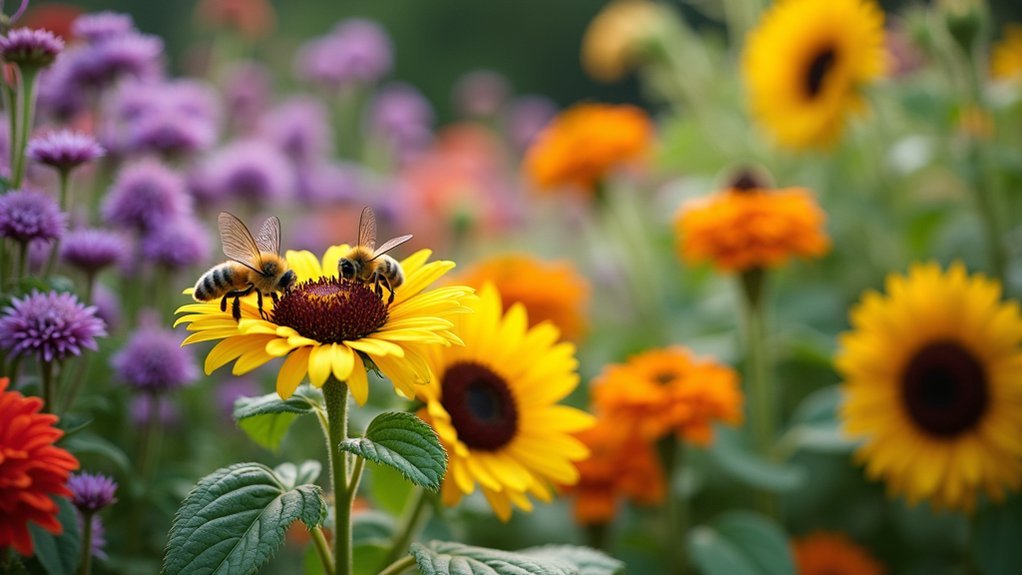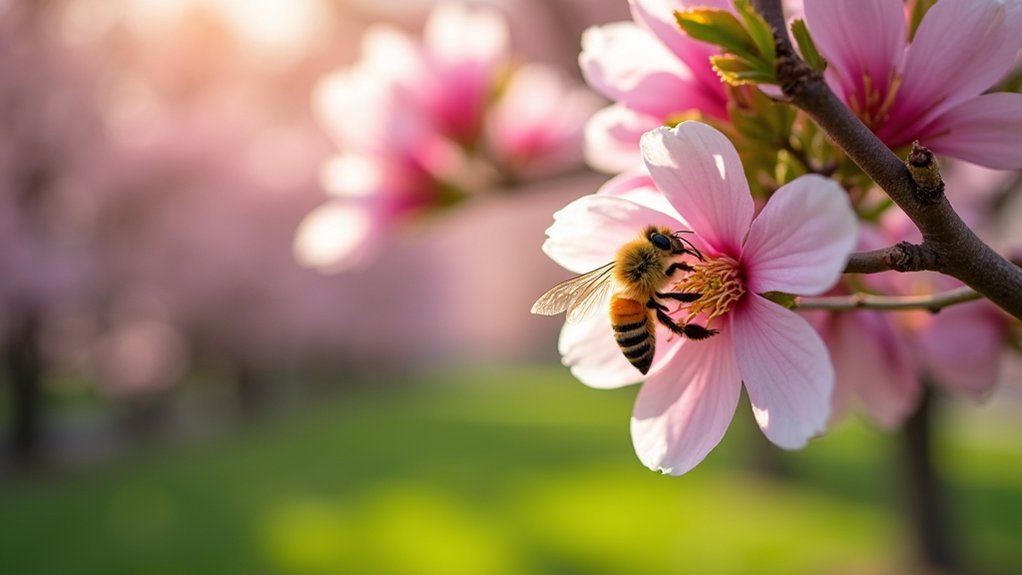Urban pollinators feast on nectar and pollen from diverse native plants along city garden trails. You'll find bees visiting purple coneflowers and milkweed, while butterflies seek specific host plants for their larvae. Hummingbirds prefer tubular red flowers like salvia, and moths rely on night-blooming jasmine and evening primrose. Creating gardens with overlapping bloom cycles guarantees these essential creatures have continuous food sources from early spring through late fall. Discover how your plant choices can transform city spaces into pollinator buffets.
Essential Nectar Sources for Urban Pollinators

While concrete and steel dominate city landscapes, urban gardens serve as essential refueling stations for pollinators. These busy creatures primarily depend on nectar from flowering plants for the energy they need to survive and reproduce.
You'll support the greatest diversity of pollinators by planting native plants like purple coneflower and milkweed. Different pollinators need access to flowers with varying shapes, colors, and sizes based on their feeding adaptations.
To create a pollinator-friendly garden, incorporate both annuals and perennials that bloom in succession. Goldenrod and asters are excellent choices for late-season nectar when other sources become scarce.
Seasonal Bloom Cycles in City Gardens
Because pollinators remain active during different periods of the year, creating a garden with sequential blooming patterns is vital for their survival in urban environments.
You'll need to strategically select native plants that flower at different times to maintain a consistent food source for pollinators.
A year-round blooming strategy includes:
- Early spring: Plant crocuses and wildflowers to nourish bees and butterflies emerging from hibernation.
- Summer months: Incorporate coneflowers and bee balm when pollinator activity reaches its peak.
- Fall season: Add goldenrod and asters to support pollinators preparing for winter.
- Transitional periods: Include plants with overlapping blooming cycles to prevent gaps in nectar availability.
This staggered approach guarantees urban pollinators have continuous access to food throughout the growing season, greatly enhancing biodiversity in your city garden.
Native Plants That Sustain Local Bees

Although often overlooked, native plants form the backbone of healthy urban pollinator ecosystems.
You'll find that native bees are remarkably efficient pollinators—up to 17 times more effective than honeybees—but they depend heavily on specific native plants for survival.
When you incorporate wildflowers like Powderpuff and Indian blanket into your garden, you're providing essential food and nectar sources that support diverse pollinating insects throughout the growing season.
Plants like milkweed serve dual purposes, nourishing adult monarchs while hosting their larvae.
For maximum impact, include a variety of natives such as echinacea and goldenrod that bloom at different times.
This strategic planting guarantees local bees have continuous food sources, even as seasons change, strengthening biodiversity in your urban environment.
Butterfly-Specific Nutrition Along Urban Trails
You'll notice diverse feeding patterns as butterflies seek both nectar-rich flowers and alternative nutrition sources along urban trails.
Your city garden can support these pollinators by incorporating native coneflowers and asters that bloom at different times throughout the season.
When you plant specific host plants like milkweed, you're not just providing adult butterfly nutrition but also essential food sources for their developing larvae.
Urban Nectar Sources
Transforming urban trails into butterfly havens requires strategic planting of diverse nectar sources that support these delicate pollinators throughout their life cycle.
You'll attract more butterflies by incorporating native flowers that bloom sequentially throughout the growing season.
For maximum impact, include:
- Essential host plants for butterflies like milkweed, which serves as the sole food source for monarch caterpillars.
- Vibrant coneflowers and asters that provide abundant nectar for pollinators during summer and fall months.
- Colorful butterfly bushes and lantana that considerably increase visitation rates with their high nectar content.
- A variety of flower shapes and colors to attract different butterfly species, as each has unique feeding preferences.
Don't forget water sources—they're just as important as nectar for complete butterfly nutrition.
Butterfly Feeding Patterns
Butterfly nutrition extends far beyond the simple act of sipping nectar from flowers. While you'll observe butterflies extracting carbohydrate-rich nectar with their specialized proboscis, they're actually seeking a complex diet along urban garden trails.
You can support these delicate pollinators by incorporating diverse native species that serve dual purposes. Plant nectar-rich flowers like coneflowers, asters, and lantanas that bloom in succession throughout seasons.
Don't forget to include specific host plants—like milkweed for Monarchs—where females lay eggs and caterpillars feed.
For complete butterfly nutrition, create small mud puddles or shallow water dishes along your garden trail. These provide essential minerals butterflies can't get from nectar alone.
Many species also supplement their diet with tree sap, rotting fruit, and even nutrients from animal dung—vital resources for their reproductive success.
Creating Continuous Feeding Corridors

Creating continuous feeding corridors requires careful planning of seasonal blooms to guarantee pollinators never face food gaps as they travel through your urban garden.
You'll want to strategically place plants with overlapping flowering periods, such as pairing summer-blooming Texas Lantana with fall-blooming Liatris along connected pathways.
Seasonal Bloom Planning
While many gardeners focus on peak summer blooms, successful pollinator gardens require thoughtful planning across all seasons.
By strategically selecting plants native to your area with different flowering times, you'll create a continuous food supply for bees, butterflies, and other pollinators visiting city gardens.
To maximize your garden's ecological impact, incorporate these seasonal bloom strategies:
- Begin with early spring bloomers like crocus and snowdrop that provide essential first food for emerging pollinators.
- Shift to mid-season workhorses such as coneflowers and black-eyed Susans during summer months.
- Extend feeding opportunities with late bloomers including goldenrod and asters as temperatures cool.
- Maintain at least three different flowering species at any given time to support diverse dietary needs.
Regularly assess your seasonal bloom calendar and adjust based on local climate patterns.
Strategic Plant Placement
When designing your urban pollinator haven, thoughtful plant arrangement transforms scattered blooms into powerful ecological pathways.
Strategic plant placement creates continuous feeding corridors that sustain diverse pollinator communities throughout the seasons.
Cluster native plants in overlapping groups—pairing summer-blooming Texas Lantana with fall-flowering Liatris guarantees nectar availability for months.
You'll maximize feeding opportunities by creating layers, with taller plants sheltering shorter varieties from wind while providing protected nectar zones.
For targeted support, incorporate specific host plants like Milkweed for Monarchs and Coneflowers for bees.
Remember, pollinators are essential for urban ecosystem health, so design with intention by varying flower colors, shapes, and sizes to attract different species.
This diversity encourages repeated visits, turning your garden trail into a thriving pollinator highway rather than isolated feeding stops.
Hummingbird Favorites in Houston Gardens
As vibrant flashes of emerald and ruby dart through Houston gardens, hummingbirds seek specific floral partners that satisfy their extraordinary energy needs.
Like living gemstones on wings, hummingbirds search Houston gardens for floral companions that fuel their remarkable metabolic demands.
These tiny pollinators thrive on Houston's native flowers, consuming twice their body weight in nectar daily to fuel their rapid wing beats.
You'll attract these aerial jewels by planting:
- Red salvia – Tubular blooms with the perfect nectar concentration (20-30%)
- Trumpet vine – High-energy flowers that support hummingbirds' caloric requirements
- Coral honeysuckle – Native option providing reliable nectar sources
- Year-round bloomers – Variety ensures continuous feeding opportunities
Don't forget that hummingbirds supplement their sugary diet with protein-rich insects and spiders, especially during nesting season.
The Role of Flowering Trees in Pollinator Diets

Towering above garden beds, flowering trees serve as essential nutrition hubs in urban pollinator ecosystems. You'll find these arboreal giants provide critical nectar and pollen resources when pollinators emerge hungry after winter. Their sugar-rich blossoms offer perfect energy sources for bees and butterflies traversing city landscapes.
| Tree Type | Bloom Time | Pollinator Benefit |
|---|---|---|
| Redbud | Early Spring | First nectar source |
| Dogwood | Mid-Spring | High pollen content |
| Apple | Late Spring | Larvae food in fruit |
| Cherry | Early Spring | Extended sugar access |
When you plant flowering trees along garden trails, you're creating biodiversity hotspots. They don't just feed adult pollinators—many species support larvae development through their fruits, completing essential lifecycle needs in urban environments.
Drought-Resistant Buffet Options for Pollinators
Urban gardens can offer abundant nourishment for pollinators with native nectar sources like goldenrod and coneflower that thrive even during water restrictions.
You'll find that drought-resistant options such as salvia and yarrow create reliable pollen stations throughout the growing season, supporting diverse bee and butterfly populations.
Native Nectar Sources
While city gardeners often struggle with limited space and unpredictable weather, native nectar sources offer a perfect solution for attracting essential pollinators. Incorporating plants like echinacea, milkweed, and salvia into your garden creates a welcoming habitat that supports both native pollinators and the broader ecosystem.
Consider these drought tolerant options for your urban oasis:
- Plant varieties that bloom in succession – Goldenrod and yarrow provide late-season nectar when other sources diminish.
- Choose climate-adapted species – Native plants naturally thrive in local conditions with minimal intervention.
- Mix perennials strategically – Guarantee continuous nectar availability throughout growing seasons.
- Include specialized nectar sources – Agastache and lavender attract diverse pollinators while requiring less water.
These resilient plants connect your garden to the broader ecological community while requiring less maintenance than non-native alternatives.
Water-Wise Pollen Stations
As climate change intensifies drought conditions in urban areas, creating water-wise pollen stations offers a sustainable solution for supporting pollinators without excessive water use.
You'll find that drought-resistant plants like agastache, lavender, and salvia aren't just water-efficient—bees love their abundant nectar and pollen.
Incorporate native species such as cone flowers and milkweed into your pollinator gardens to enhance urban biodiversity while requiring minimal irrigation.
These hardy plants provide habitat for local bees and butterflies that have adapted to your region's natural conditions.
Don't forget to include shallow water sources with landing stones in your design.
These complement your pollen stations by giving thirsty pollinators a place to hydrate during dry spells, creating a complete oasis that helps these essential creatures thrive despite urban challenges.
Night-Blooming Plants for Moth Pollinators

When darkness falls, a hidden world of pollination comes to life in city gardens. Night-blooming plants unfurl their pale, luminous flowers after sunset, inviting moths to feast on their sweet nectar.
You'll support vital nocturnal pollinators by adding these fragrant beauties to your urban landscape.
Create a moth-friendly garden with these night bloomers:
- Moonflower (Ipomoea alba) – Their large white blooms reflect moonlight, creating natural beacons for moths.
- Evening primrose (Oenothera biennis) – Opens dramatically at dusk with a sweet fragrance.
- Night-blooming jasmine (Cestrum nocturnum) – Emits an intense perfume that carries through night air.
- Night-scented stock (Matthiola longipetala) – Provides specialized nectar for moths with long proboscises.
These plants guarantee pollination continues around the clock in your garden ecosystem.
Urban Wildflower Patches as Pollinator Restaurants
Transforming even the smallest urban spaces into wildflower patches creates vital feeding stations for hungry pollinators throughout the growing season. When you plant native wildflowers like milkweed, echinacea, and goldenrod, you're fundamentally setting up a diverse menu that meets the nutritional needs of bees, butterflies, and other pollinators.
| Wildflower | Blooming Season | Primary Visitors |
|---|---|---|
| Milkweed | Early Summer | Monarch Butterflies |
| Echinacea | Mid-Summer | Solitary Bees |
| Goldenrod | Late Summer | Honeybees |
| Aster | Fall | Syrphid Flies |
| Blazing Star | Summer | Hummingbirds |
These urban gardens aren't just restaurants—they're complete habitats offering shelter and nesting sites alongside food. By creating these biodiversity hotspots in cities, you'll support pollinator populations year-round while enhancing the ecological health of your community.
Frequently Asked Questions
What Do Pollinators Feed On?
Pollinators feed on nectar and pollen from flowers. You'll notice they get carbohydrates from nectar and proteins from pollen, which they need for energy and reproduction. They're particularly attracted to native blooms.
How Do I Attract Pollinators to My Vegetable Garden?
Plant diverse native flowers that bloom throughout the season, include butterfly host plants, avoid pesticides, provide water sources, and leave natural areas. You'll create a pollinator paradise that'll boost your vegetable garden's productivity.
What Are Pollinators Most Attracted To?
Pollinators are most attracted to native plants in your garden. You'll see them flock to diverse flower shapes and colors, especially when you've planted continuous bloomers that provide nectar and pollen throughout the growing season.
What Plants Are Best for a Pollinator Garden?
Plant native species like echinacea, milkweed, and yarrow in your pollinator garden. You'll want varieties with different bloom times to provide continuous nectar sources. Don't forget to include Pycnanthemum muticum and Calamentha nepeta for maximum attraction.
In Summary
You've got the power to transform your city's garden trails into thriving pollinator buffets. By planting diverse, native species that bloom throughout the seasons, you're creating essential feeding corridors. Don't forget night-blooming options for moths and drought-resistant varieties for changing climates. Your thoughtful garden choices directly support urban biodiversity, ensuring bees, butterflies, and other pollinators won't go hungry as they navigate our concrete jungles.





Leave a Reply